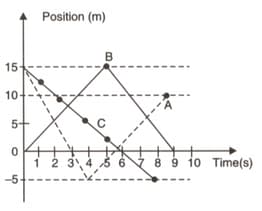" is used in case of variable acceleration". Comment.

Important Questions on Motion
State which of the following situations are possible and give an example of each of these:
(a) A body having acceleration but zero velocity.
(b) A body moving horizontally with an acceleration in a vertical direction.
(c) A body moving with a constant velocity in an accelerated motion.
A body moves with a velocity of for . Then its velocity increases uniformly to in next . Thereafter, its velocity begins to decrease at a uniform rate until it comes to rest after . Plot a velocity-time graph.
A body moves with a velocity of for . Then its velocity increases uniformly to in next . Thereafter, its velocity begins to decrease at a uniform rate until it comes to rest after . Mark the portions of the graph to show when the motion of the body is uniform and when it is non-uniform on the velocity-time graph.
A body moves with a velocity of for . Then its velocity increases uniformly to in next . Thereafter, its velocity begins to decrease at a uniform rate until it comes to rest after . From the velocity-time graph, find the total distance moved by the body in initial and initial and in the last .
Discuss the graphs and shown in the figure. Compare the total distance travelled and the displacements. Which portion of graph represents a motion in which displacement is zero?

A sprinter in a race covers in first second, in next , in another and finishes the race in .
Calculate the average velocity of the sprinter. You may assume that during any given time interval the velocity is uniform.
A sprinter in a race covers in first second, in next , in another and finishes the race in .
In which time interval, is the average velocity attained by the sprinter maximum? State this velocity in appropriate units.
